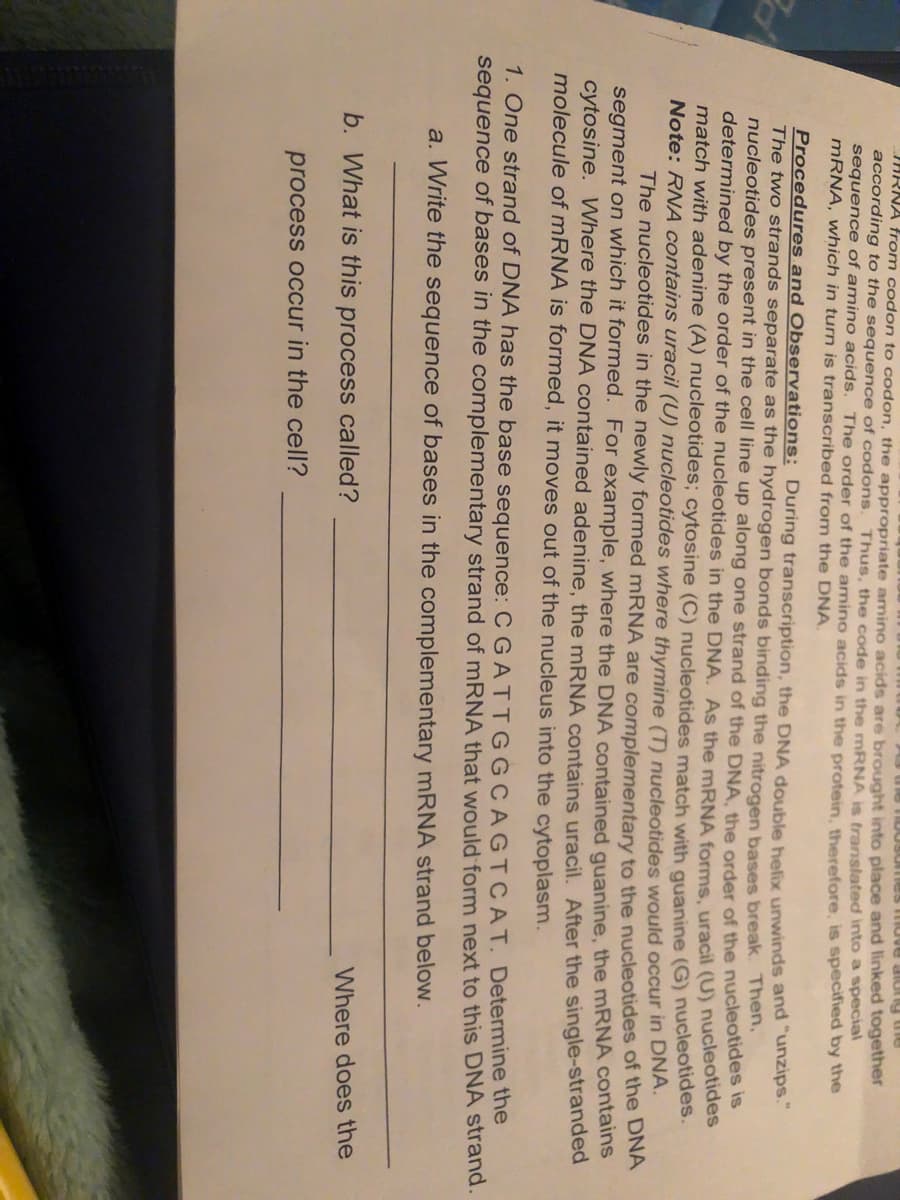UjtUJIne (C) Tiucleotides match with guanine Note: RNA contains uracil (U) nucleotides where thymine (T) nucleotides would The nucleotides in the newly formed mRNA are complementary to the nu segment on which it formed. For example, where the DNA contained guanine, cytosine. VWhere the DNA contained adenine, the mRNA contains uracil. After molecule of mRNA is formed, it moves out of the nucleus into the cytoplasm. 1. One strand of DNA has the base sequence: CGATTGGCAGTCAT sequence of bases in the complementary strand of MRNA that would form ne a. Write the sequence of bases in the complementary MRNA strand b b. What is this process called? process occur in the cell?
UjtUJIne (C) Tiucleotides match with guanine Note: RNA contains uracil (U) nucleotides where thymine (T) nucleotides would The nucleotides in the newly formed mRNA are complementary to the nu segment on which it formed. For example, where the DNA contained guanine, cytosine. VWhere the DNA contained adenine, the mRNA contains uracil. After molecule of mRNA is formed, it moves out of the nucleus into the cytoplasm. 1. One strand of DNA has the base sequence: CGATTGGCAGTCAT sequence of bases in the complementary strand of MRNA that would form ne a. Write the sequence of bases in the complementary MRNA strand b b. What is this process called? process occur in the cell?
Biochemistry
6th Edition
ISBN:9781305577206
Author:Reginald H. Garrett, Charles M. Grisham
Publisher:Reginald H. Garrett, Charles M. Grisham
Chapter28: Dna Metabolism: Replication, Recombination, And Repair
Section: Chapter Questions
Problem 20P: Figure 28.41 gives some examples of recombination in IgG codons 95 and 96, as specified by the Vkand...
Related questions
Concept explainers
Gene Interactions
When the expression of a single trait is influenced by two or more different non-allelic genes, it is termed as genetic interaction. According to Mendel's law of inheritance, each gene functions in its own way and does not depend on the function of another gene, i.e., a single gene controls each of seven characteristics considered, but the complex contribution of many different genes determine many traits of an organism.
Gene Expression
Gene expression is a process by which the instructions present in deoxyribonucleic acid (DNA) are converted into useful molecules such as proteins, and functional messenger ribonucleic (mRNA) molecules in the case of non-protein-coding genes.
Topic Video
Question

Transcribed Image Text:Iove aIung the
HRNA from codon to codon, the appropriate amino acids are brought into place and linked together
according to the sequence of codons. Thus, the code in the mRNA is translated into a special
sequence of amino acids. The order of the amino acids in the protein, therefore, is specified by the
MRNA, which in turn is transcribed from the DNA.
Procedures and Observations: During transcription, the DNA double helix unwinds and "unzips.
The two strands separate as the hydrogen bonds binding the nitrogen bases break. Then,
nucleotides present in the cell line up along one strand of the DNA, the order of the nucleotides
determined by the order of the nucleotides in the DNA. As the mRNA forms, uracil (U) nucleotides
match with adenine (A) nucleotides; cytosine (C) nucleotides match with guanine (G) nucleotides.
Note: RNA contains uracil (U) nucleotides where thymine (T) nucleotides would occur in DNA.
The nucleotides in the newly formed mRNA are complementary to the nucleotides of the DNA
segment on which it formed. For example, where the DNA contained quanine, the MRNA contains
cytosine. Where the DNA contained adenine, the MRNA contains uracil. After the single-stranded
molecule of MRNA is formed, it moves out of the nucleus into the cytoplasm.
1. One strand of DNA has the base sequence: CGATTGGCAGTCAT. Determine the
sequence of bases in the complementary strand of mRNA that would form next to this DNA strand.
a. Write the sequence of bases in the complementary MRNA strand below.
b. What is this process called?
Where does the
process occur in the cell?
Expert Solution
This question has been solved!
Explore an expertly crafted, step-by-step solution for a thorough understanding of key concepts.
Step by step
Solved in 3 steps

Knowledge Booster
Learn more about
Need a deep-dive on the concept behind this application? Look no further. Learn more about this topic, biology and related others by exploring similar questions and additional content below.Recommended textbooks for you

Biochemistry
Biochemistry
ISBN:
9781305577206
Author:
Reginald H. Garrett, Charles M. Grisham
Publisher:
Cengage Learning

Biochemistry
Biochemistry
ISBN:
9781305577206
Author:
Reginald H. Garrett, Charles M. Grisham
Publisher:
Cengage Learning